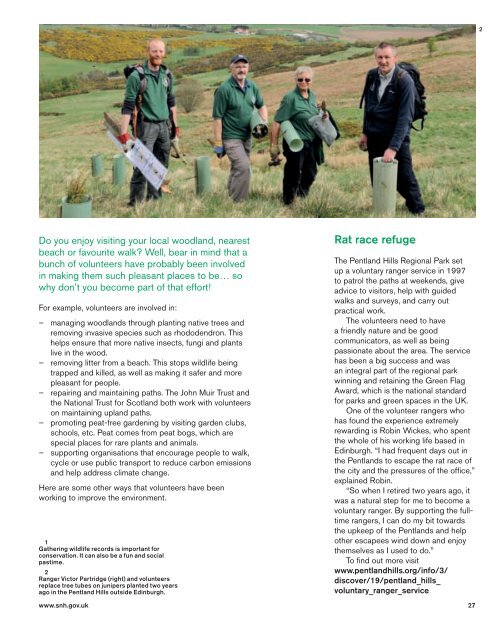The Nature of Scotland â Autumn 2011 â Issue 13
The Nature of Scotland â Autumn 2011 â Issue 13
The Nature of Scotland â Autumn 2011 â Issue 13
Create successful ePaper yourself
Turn your PDF publications into a flip-book with our unique Google optimized e-Paper software.
2<br />
Do you enjoy visiting your local woodland, nearest<br />
beach or favourite walk? Well, bear in mind that a<br />
bunch <strong>of</strong> volunteers have probably been involved<br />
in making them such pleasant places to be… so<br />
why don’t you become part <strong>of</strong> that effort!<br />
For example, volunteers are involved in:<br />
– managing woodlands through planting native trees and<br />
removing invasive species such as rhododendron. This<br />
helps ensure that more native insects, fungi and plants<br />
live in the wood.<br />
– removing litter from a beach. This stops wildlife being<br />
trapped and killed, as well as making it safer and more<br />
pleasant for people.<br />
– repairing and maintaining paths. <strong>The</strong> John Muir Trust and<br />
the National Trust for <strong>Scotland</strong> both work with volunteers<br />
on maintaining upland paths.<br />
– promoting peat-free gardening by visiting garden clubs,<br />
schools, etc. Peat comes from peat bogs, which are<br />
special places for rare plants and animals.<br />
– supporting organisations that encourage people to walk,<br />
cycle or use public transport to reduce carbon emissions<br />
and help address climate change.<br />
Here are some other ways that volunteers have been<br />
working to improve the environment.<br />
1<br />
Gathering wildlife records is important for<br />
conservation. It can also be a fun and social<br />
pastime.<br />
2<br />
Ranger Victor Partridge (right) and volunteers<br />
replace tree tubes on junipers planted two years<br />
ago in the Pentland Hills outside Edinburgh.<br />
Rat race refuge<br />
<strong>The</strong> Pentland Hills Regional Park set<br />
up a voluntary ranger service in 1997<br />
to patrol the paths at weekends, give<br />
advice to visitors, help with guided<br />
walks and surveys, and carry out<br />
practical work.<br />
<strong>The</strong> volunteers need to have<br />
a friendly nature and be good<br />
communicators, as well as being<br />
passionate about the area. <strong>The</strong> service<br />
has been a big success and was<br />
an integral part <strong>of</strong> the regional park<br />
winning and retaining the Green Flag<br />
Award, which is the national standard<br />
for parks and green spaces in the UK.<br />
One <strong>of</strong> the volunteer rangers who<br />
has found the experience extremely<br />
rewarding is Robin Wickes, who spent<br />
the whole <strong>of</strong> his working life based in<br />
Edinburgh. “I had frequent days out in<br />
the Pentlands to escape the rat race <strong>of</strong><br />
the city and the pressures <strong>of</strong> the <strong>of</strong>fice,”<br />
explained Robin.<br />
“So when I retired two years ago, it<br />
was a natural step for me to become a<br />
voluntary ranger. By supporting the fulltime<br />
rangers, I can do my bit towards<br />
the upkeep <strong>of</strong> the Pentlands and help<br />
other escapees wind down and enjoy<br />
themselves as I used to do.”<br />
To find out more visit<br />
www.pentlandhills.org/info/3/<br />
discover/19/pentland_hills_<br />
voluntary_ranger_service<br />
www.snh.gov.uk 27

















